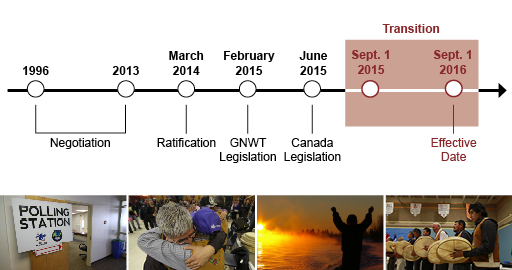
In the 1970s the Dene Nation worked on negotiating a land claim for all Dene regions. At that time, Canada did not recognize that Dene had a right to govern themselves. The Dene Nation disagreed, and insisted that their right to self-government existed. By 1990, Canada agreed to include a chapter in the land claim promising to negotiate self-government after the land claim was signed. The Sahtu then signed its land claim in 1993.
When the community of Deline decided to negotiate a self-government agreement, the Deline Elders had strong views that the community should have one government that brought everyone together. This was based in part on the teachings of Prophet Ehtseo Ayah. The Elders believed that too many organizations were responsible for governing the community: a First Nation created by Canada’s Indian Act, the Land Corporation created under the Sahtu Land Claim, and a Charter Community created by the GNWT. The Elders believed that the community could be governed better and that people would work together better if there was one organization. They also wanted to make sure that the one government would have more control over decision making in the community. This vision was supported by the community.
The community knew that to have one government, they would have to negotiate with Canada and the GNWT to set that up.
In 1995, the community started talks with Canada and the GNWT about self-government to work out the details of what they would negotiate. In 1996, they made an agreement about what they would negotiate and how they would do this, so that the three parties understood what they had to do and what they wanted to achieve. That agreement was called a Process and Schedule Agreement.
Then, between 1996 and 2003, Deline, Canada and the GNWT negotiated the Self-Government Agreement-in-Principle. The Agreement–in-Principle, signed in Deline on August 23, 2003, described the major parts of the self-government agreement: the new government model, its main responsibilities, and how its authorities would work with the authorities of GNWT and Canada, but did not include all the details.
The Agreement-in-Principle was signed by the Minister of Indian Affairs and Northern Development, the Minister of Aboriginal Affairs of the GNWT, the Chief of the Deline Dene Band and the President of the Deline Land Corporation. This agreement, in effect, represents an important community approval of the Aboriginal public government model.
After the Agreement-in-Principle was signed, Deline, Canada and the GNWT began to negotiate the Final Self-Government Agreement (FSGA). This included discussions about how self-government would be financed, what the parties must do to make sure the agreement will work the way it is supposed to, and how the self-government agreement and the land claim will work together. At that time the Deline Self-Government Team held a series of workshops where community members developed a community constitution.
The negotiators always kept in mind that almost half of Deline’s First Nation members and land claim beneficiaries live outside of Deline and most of them live in Yellowknife. In 2010, a Yellowknife office was established, which is responsible for making sure that Deline members and beneficiaries living outside of Yellowknife were aware of the agreement and could ask questions and get answers and information.
On December 19, 2013, the Deline First Nation, Deline Land Corporation, and the governments of Canada and the NWT initialled the Deline Final Self-Government Agreement. This is the document that would lay the groundwork for Deline self-government.
Before the agreement could be finalized, it had to be approved by the members of the Deline First Nation and Deline beneficiaries of the Sahtu land claim through a ratification vote. On March 12, 2014, the eligible voters—roughly half of whom lived outside of the community of Deline—voted overwhelmingly to approve the final agreement.
Following this ratification, the territorial and federal governments also had to approve the agreement and pass legislation to recognize it. Both governments passed laws recognizing the Deline Self-Government Agreement in 2015. In September 2015, the Deline First Nation, Deline Land Corporation and Deline Charter Community began the process of preparing to dissolve these three bodies and merge their functions into a single Deline Got’ine Government. This government will take effect on September 1, 2016.




